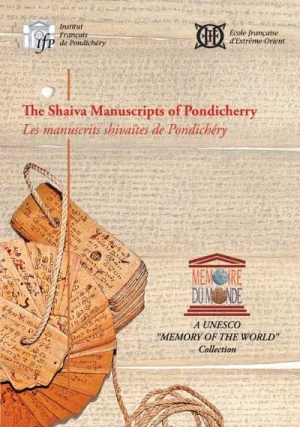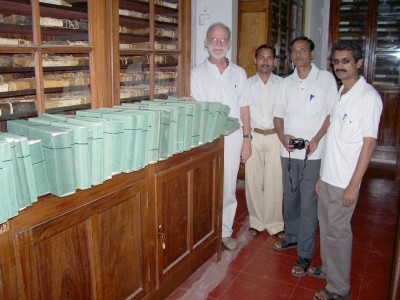
Muktabodha photographic staff with
bundles of paper transcripts of the IFP
photographed over several days
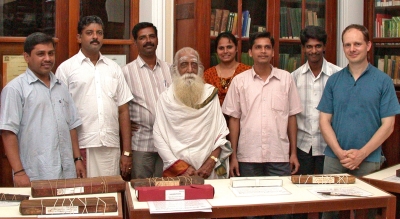
The current cataloguing team of the IFP and EFEO
The catalogue and complete collection of photographic facsimiles of the 1144 paper transcripts of the French Institute of Pondicherry (IFP) is now made available on the internet to the world scholarly community through a collaborative agreement between the Muktabodha Indological Research Institute, the French Institute of Pondicherry, and the Ecole française d'Extrême-Orient (French School of Asian Studies). These 1144 recent paper Devanagari transcripts (containing over 2000 mostly Shaiva texts and over 200,000 pages) were commissioned or copied by scholars of the French Institute of Pondicherry (IFP) and the Ecole française d'Extrême-Orient (EFEO) over a period of more than thirty years. Muktabodha has been preserving Sanskrit texts and manuscripts by microfilm and digitization for the last ten years and since 2003 has been disseminating core Shaiva texts both as photographic facsimiles and as searchable e-texts to the world scholarly community via its on-line digital library. The combined effort, commitment, resources and experience of these three organisations has made it possible to make this major collection available.
One third of the transcripts were scanned by the staff of the IFP and EFEO and the remaining two-thirds were digitally photographed and processed for the internet by the staff of Muktabodha. All of these scans and photographic images were processed for the internet by Muktabodha. The immense job of cataloguing the collection was accomplished by a small cataloguing staff of the IFP and EFEO never exceeding five or six persons. Similarly the digital photography of the collection was accomplished by a small team from Muktabodha never exceeding four people in approximately 90 days of photography (On the most productive day over 11,000 manuscript pages were photographed). The offline catalogue and database was designed and developed by the staff of the IFP and EFEO while the on-line web-based catalogue software and database was developed and implemented by Muktabodha using open-source software. The web-host server is managed by Muktabodha. And of course the existence of the collection is a result of over thirty years of scholarship of the IFP and EFEO.
The paper transcripts of the IFP are a core component of the "Shaiva
Manuscripts in Pondicherry" collection which in recognition of its importance
was deemed a UNESCO
"Memory of the World" Collection in 2005, in response to an application
jointly submitted by the IFP, the EFEO, and the
National Mission for Manuscripts (NMM) , an initiative of the Indian Central
Government. This is the largest collection of Shaiva Siddhanta texts in
the world. Many of these Saiddhantika texts are among the paper transcripts.
The transcripts are clearly written in the well-known Devanagari script,
whereas many of the original manuscripts from which they have been transcribed,
many of which it would be difficult to trace today, are in other less well-known
South Indian scripts, notably Grantha.
HISTORY OF THE COLLECTION
by Dominic Goodall
The EFEO and IFP and their involvement with Shaiva Studies
At the time of the foundation of the Ecole française d'Extrême-Orient (French School of Asian Studies) in 1900, its headquarters were in Hanoi, in the Indo-Chinese peninsula, and its members saw themselves as interpreters of the “sinicised” and “indianised” cultures of that region. The great monuments of Vietnam and Cambodia that were once Shaiva and Vaishnava temples, and more particularly their Sanskrit inscriptions, inevitably led members of the EFEO to turn to the West, to India, to find texts and practices in living Indian temples that could help to reconstruct something of the religious history of the long period of powerful Indian cultural influence.
Much of the literature that was most relevant to such reconstruction, however, had not been published, for, at the beginning of the twentieth century, this corpus, the corpus of the oldest Hindu tantric literature, was virtually unknown.
Starting in 1911, the Kashmir Series of Texts and Studies began gradually to unveil to scholars a number of Shaiva tantric works that had been transmitted in Kashmir, particularly philosophical works composed in the Kashmir valley in between the 8th and 13th centuries. But the works of the tantric current that appears in this period to have dominated the Shaiva religion across most of the Indian subcontinent and beyond, namely the Shaiva Siddhanta, remained relatively neglected.
In recent centuries, the Tamil-speaking South is the only area where the vast corpus of Sanskrit texts of the Shaiva Siddhanta has continued being copied and so transmitted to the present day. When, therefore, Jean Filliozat, secured a foothold on Indian soil for French indological research, he created an ideal institutional base for setting about the study of a forgotten chapter in the religious history of Asia.
It was Jean Filliozat, overall Director of the EFEO from 1956 to 1977, who took the initiative of setting up in Pondicherry, which had just become part of the new India, an interdisciplinary research centre to study India. Thus the treaty of cession of French territories to the Indian Union provides for the creation of the French Institute of Pondicherry (IFP), which has since remained an organ of the French Ministry of Foreign Affairs.
The Collection
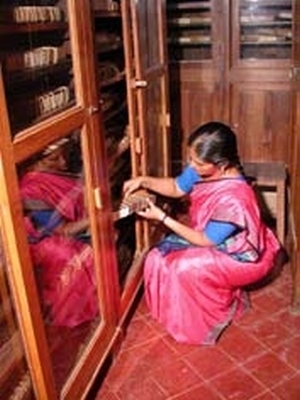
Mrs. Shanty Rayapoullé, librarian,
in the manuscript room of the
Pondicherry Center of the EFEO
The manuscript collection of the French Institute of Pondicherry (IFP) was started in the 1950s under the auspices of its founder-director, the polymath Jean Filliozat, with a view to collecting all material relating to Shaiva tantras, the scriptures of a Shaiva religious tradition called the Shaiva Siddhanta, which has flourished in South India since the 7th century AD. Shaiva tantras (or agamas) were in the 1950s neglected and virtually unknown to most scholars of Sanskrit in India as well as in the West. The efforts of the IFP have brought them to the attention of the scholarly world and seen many of them published.
The manuscripts were gathered, many of them by Pandit N. R. Bhatt, from the private collections of priests and monasteries across South India. When the manuscripts themselves could not be obtained, transcripts in Devanagari script were made. Such transcripts were also made of manuscripts held in other libraries, such as the Government Oriental Manuscripts Library (Madras), the Adyar Library and Research Centre (Madras), the Trivandrum Oriental Research Institute and Manuscripts Library (Trivandrum), the Saraswati Mahal Library (Tanjavur), the Oriental Research Institute (Baroda), the Sarasvati Bhavan (Varanasi), and there are also a number of transcripts of palm-leaf manuscripts kept in the IFP itself.
The collection of the IFP now consists of approximately 8600 palm-leaf codices, most of which are in the Sanskrit language and written in Grantha script (others are in Tamil, Malayalam, Telugu, Nandinagari and Tulu scripts) and a further 1144 transcripts on paper in Devanagari script.
The bulk of the IFP’s collection comprises manuscripts of tantras of the Shaiva Siddhanta, commentaries thereon, Shaiva ritual manuals, and miscellaneous compendia, manuals, handbooks, and notes of Shaiva priests. This collection is thus unique in that it is the largest collection of Saiddhantika manuscripts in the world, as has been now recognised by UNESCO.
Cataloguing
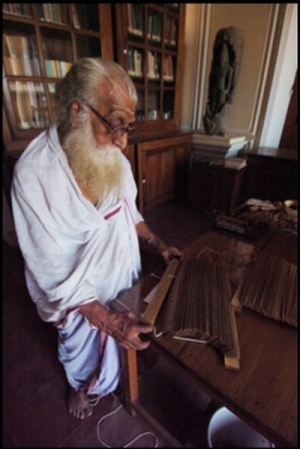
Pandit Sambhandashivacharya of the IFP
has decades of cataloguing experience
At present there is a rudimentary handlist of the entire collection and for about half of the collection cataloguing cards have been filled out with more information than is available on this handlist. Four volumes of a Descriptive Catalogue were released between 1986 and 2002 with the financial assistance of UNESCO on the recommendation of the International Council of Philosophy and Human Sciences; but these volumes cover only 475 codices. For the remaining thousands, no published source of information has hitherto been available. We began to compile a computer catalogue in 1999, of which this on-line resource covering the 1144 transcripts of the collection is the first large-scale result.
We hope that our project will raise awareness of those parts of India’s rich literary heritage that are gradually rotting away unread.
Why select these transcripts?
This on-line digital library in fact serves more than one purpose: we are of course cataloguing and making widely available a body of important sources, but we are thereby also creating a photographic record that will help to preserve images of them for posterity. Why did we choose first to cover the most recent part of the collection, the twentieth-century paper manuscripts?
Two considerations led to this choice:
- the transcripts are clearly written in ink on paper in the well-known Devanagari script, whereas the palm-leaf manuscripts are, for the most part, incised in minuscule Grantha lettering, a script known to far fewer scholars world-wide.
- the transcripts, although all recent (most were produced between 1960 and 1980), used paper that is now decaying more rapidly than the palm-leaf sources.
Much virtual ink has been spilt, in recent times, over the problems of digitising as a strategy for conservation. Some are of the opinion that digitising is only of value as a tool for rapid diffusion, that conservation of the originals should never be neglected and that, if "data-migration" is seen to be inevitable, what is required is high-quality microfilm rather than digitisation. Now we are of course committed to conserving our originals for as long as possible, but we are aware that our manuscripts have a limited shelf-life. Well-produced microfilm from which minuscule South Indian lettering is legible is not only expensive and difficult to produce, but it too has a limited shelf-life. The natural choice for us seemed clear: digital. It may be true that the rapid evolution of digital formats put the life of all digital images at risk, but it seems to us that this risk is something we can handle, either by regularly updating the formats in which we store our digital images, or, as a last resort, producing fresh print-outs using reliable ink and good paper.
Some words about errors
It will be evident to every user that the large quantity of meta-data contained in our database-catalogue has been produced and corrected (and, alas, recorrected) over a long period of time and by rather a large number of persons, all of them with somewhat different notions of the rules of the languages involved. We have considerably reduced the once dazzlingly various English morphology and we have tamed some of the wilder and more muscular syntax, but some oddities inevitably remain.
k.santum arhantu vidvaa.msa.h kasya naasti vyatikrama.h||
May the learned forgive : who is there who never errs ?
Similarly, in the quotations of the beginnings and ends of texts, which
we hope will prove useful for those searching certain terms or themes, there
are a number of irregularities. Many of these, of course, are errors of
the original and have therefore been faithfully transcribed. But we would
not be so rash as to claim, as do a number of the scribes,
yaad.r"sa.m pustaka.m d.r.s.tvaa taad.r"sa.m likhita.m mayaa|
abaddha.m vaasubaddha.m vaa mama do.so na vidyate||
I've copied this book just the way it is:
If incoherent or ill-expressed
The fault is not a fault of mine.
One area in which there is still considerable irregularity, but that happily should not impair either searchability or intelligibility, is that of word-splits in the Sanskrit.
bindudurlipivisargaviithikaapa"nkti"s.r.mgapadabhedaduu.sa.nam|
hastavegajam abuddhipuurvaja.m k.santum arhatha samiik.sya sajjanaa.h|| (T.416)
Mistakes concerning dots, poor writing,
Breathings, margins, breaks in lines,
The [shapes of] hooks, the splits of words,
-the consequence of hasty hands
And thoughtlessness-[all these], good people,
Forgive us please, if you should spot them.
We plan a few further revisions at intervals of six months
and we would of course be most grateful to users of this on-line resource
for their corrections and suggestions.
MUKTABODHA'S
COLLECTIONS
by Harry Spier
Microfilm
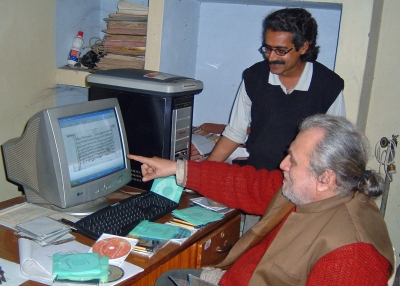
Dr. Mark Dyczkowski, Muktabodha's academic advisor in India
with Virendra Kumar Pathak, office manager in Varanasi
Part of the mission of Muktabodha is to preserve and create access to selected aspects of India's religious and philosophical traditions. A major component of Muktabodha's strategy for fulfilling this mission is the Muktabodha Digital Library Project. This was begun in 1995 as a microfilming project focusing mainly on palm-leaf Vedic Shrauta ritual manuscripts from libraries and private collections. From this phase we now have approximately 50,000 frames of microflim in our archives still awaiting cataloguing.
Kashmir Series of Texts and Studies
Since that time the focus has shifted to the preservation
of the texts of the Tantric and Agamic traditions of India. In 2003 as the
first phase of this new focus, the core texts of Kashmir Shaivism were made
available to the scholarly community with 75 volumes of the Kashmir Series
of Texts and Studies (K.S.T.S.) as the first collection of the Muktabodha
digital library.
To date over 15,000 volumes the K.S.T.S. series
have been downloaded from the digital library by users and institutions
in over 50 countries.
Searchable e-texts
One of Muktabodha's goals in furthering its mission
is to encourage scholars to produce critical editions of Tantric and Agamic
texts. To further this goal, Muktabodha began adding searchable e-texts
to its digital library. It is hoped that these searchable e-texts will be
useful tools for those scholars engaged in the production of Tantric/Agamic
editions. In 2005 Dr. Mark S.G. Dyczkowski
joined Muktabodha as its Academic
Advisor in India. Under his guidance and using a team trained by him
over many years in data-entrying and collating Sanskrit manuscripts, Muktabodha
began adding its first searchable e-texts to its on-line digital library.
The focus for these searchable e-texts has been to start with Kashmir Shaivism
at the center and expand outward into the Tantric and Agamic milieu in which
it grew. These searchable e-texts are both from previously published printed
editions now out of copyright and from previously unpublished manuscripts.
At present we have approximately 90 searchable e-texts in the library. These
searchable e-texts include major texts from Kashmir Shaiva, Kaula-Trika,
Bhairava, Natha Yoga, and Pancaratra traditions. Eleven of the searchable
e-texts are from previously unpublished manuscripts either edited or provisionally
edited by Dr. Dyczkowski. These are mainly (though not exclusively) either
Kali-krama or Trika/Kaula/Bhairava texts.
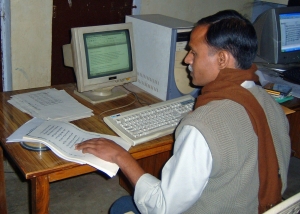
Dharmendra Srivastava, data-entry supervisor Muktabodha,
inputing from a photocopy of a Grantha manuscript
To date 87 e-texts have been added to the Muktabodha digital library consisting of over 370,000 lines of Sanskrit. 230,000 of these lines were data-entered by our data-entry staff, 105,000 lines were converted from electronic devanagari typeset editions created by Dr. Sudhakar Malaviya using computer programs written in-house by Harry Spier. And perhaps most importantly there are over 35,000 lines from Tantric/Agamic manuscripts edited or partially edited by Mark Dyczkowski.
All typed searchable e-texts are produced by teams of two, with the first member of the team entering the text, and the second rechecking the e-text against the original manuscript or edition. The final e-text is then reviewed by Mark Dyczkowski. The data-entry staff all have Devanagari as their native script and have been trained in and data-entry from old Newari and Grantha scripts for many years.
Paper transcripts of the IFP
The latest, largest and most important addition to our on-line digital library is of course the collection of the mostly Shaiva paper transcripts of the IFP (the central importance of which is explained by Dr. Dominic Goodall in "History of the Collection"). In addition to the immense importance of the paper transcripts of the IFP as a core component of the largest collection of Shaiva Siddhanta manuscripts in the world, they complement Muktabodha's other Tantric/Agamic collections which till now have not had a major Saiddhantika component.
Other collections in Muktabodha's digital library
Muktabodha has also made available on-line a small representative sample of our collection of digital photographs of Vedic manuscripts from Gokarna, Maharashtra. These manuscripts are from the private collections of the Joglekar, Koglekar and Samba Dikshita families and are from various schools including Hiranyakesin, Baudhayana, and Asvalayana. In the future it is planned to add the entire collection of approximately 200 manuscripts to the digital library.
Also available in our digital library are 24 volumes of the Shaiva Siddhanta texts of the Devikottai series published in the first quarter of the twentieth century.
Usage of the Muktabodha on-line digital library
Since the digital library was initiated in 2003, there have been over 20,000 logins.
Over 771,000 pages have been viewed on-line and about 18,000 separate complete texts
have been downloaded by users from 75 countries. The highest usage measured by logins is
from India followed by users from American higher education institutions, closely followed in turn by Russia,
the United Kingdom, Italy, Australia, Germany, Canada, France, the Ukraine, Romania, Brazil, Poland and Japan.
Manuscript Image Formats
All images of manuscripts and books in the Muktabodha on-line digital library are made
available in two formats, DjVu and PDF. The DjVu format is ideal for the viewing of large books and manuscripts
on the web for several reasons:
-
There is a single link to an entire book or manuscript encoded with DjVu software.
Each page of the manuscript or book is actually a separate file but, without the user's being aware, the link actually
points to a directory file to the book, so even if the
entire book or manuscript is several hundred megabytes,
you are only downloading a page (typically only about 250k) at a time,
which is very fast. Also as you are reading one page the next one is being downloaded.
- The DjVu files are encoded in what is known as "wavelet" technology. Essentially this means that they are stored as mathematical formulas describing curves. This allows the page images to be zoomed with almost no loss of quality to 1200% and without getting the jagged edges (called jaggies) that occur if the image is stored as a pattern of pixels.
The PDF format is ideal for the downloading and disseminating of files of books or manuscripts because it is so universally available and known.
On-line catalogue and database software
The on-line database of the 210,000 pages of transcripts occupies 102 Gigabytes of storage and
is hosted on a Linux Apache server.
Open-source software was used for the server-side software and database.
- The MySQL open-source database is used to host the catalogue and MySQL migration tools were used to convert the IFP/EFEO Access based catalogue (developed in-house by the IFP/EFEO) to MySQL.
- The open-source PHP scripting language is used for the server-side software.
The server-side programming and the on-line catalogue user-interface were designed and programmed in-house by Muktabodha.
Imaging
Approximately one-third of the images were digitally scanned by personnel of the IFP and EFEO.
The remaining two-thirds were photographed by Muktabodha using two Fuji S9000 digital cameras.
Project Co-ordinators
Mrs. Hema Patankar, Executive Director MIRI
Dr. Jean-Pierre Muller, Director IFP
Dr. Franciscus Verellen, Director EFEO
Project Managers
Dr. Dominic Goodall, Head of the Pondicherry Centre of the EFEO, on behalf
of the IFP and EFEO
Harry Spier, Project Manager Muktabodha Digital Library, on behalf of MIRI
Cataloguing of transcripts and data-entry
Dr. Deviprasad Mishra, IFP
Anil Kumar Acharya, IFP
Dr. Nibedita Rout, EFEO
Dr. R. Sathyanaranayan, EFEO
Scanning of transcripts (commencing
in 1998)
D. Dharanidharan, IFP
B.H. Satyanarayana Bhat, IFP
Shankara Rama Sarma, IFP
L. Dorairadj, EFEO
A. Alphonse, IFP
P. Arumugam, IFP
Digital photography of transcripts
(commencing in 2005)
Harry Spier, supervisor of photography, MIRI
Virendra Kumar Pathak, MIRI
Dharmendra Srivastava, MIRI
Vinaya Mishra, MIRI
Deobrat Patel, MIRI
N.V. Ramachandran, MIRI
Catalogue and database design
Ratnadeep Datta, IFP
C. Jyotinarayanan, IFP
Dr. S.A.S. Sarma, EFEO
Dr. Dominic Goodall, EFEO
Anurupa Naik, IFP, Librarian
Processing of photographs of transcripts
for digital display on the internet
Harry Spier, MIRI, supervisor of processing in the USA
Dr. Mark Dyczkowski, MIRI, supervisor of processing in India
Virendra Kumar Pathak, MIRI
Dharmendra Srivastava, MIRI
Vinaya Mishra, MIRI
Deobrat Patel, MIRI
Design and programming of on-line
catalogue and database of transcripts
Harry Spier, MIRI
Legal and Contracts
Robert Kempter, MIRI
Dr. Dominic Goodall, EFEO
Dr. Jean-Pierre Muller, IFP
Tamali Sengupta, MIRI
Ved Prakash Khurana, MIRI
Harry Spier, MIRI
Over the years, the activities of a number of other individuals
have contributed, directly or indirectly, to the production of this
catalogue of transcripts
S. Sambandan, IFP Cataloguing of palm-leaf manuscripts
Dr. T. Ganesan, IFP Cataloguing of palm-leaf manuscripts
R. Ilakkuvan, EFEO Cataloguing of palm-leaf manuscripts
R. Subramaniam, IFP, Cataloguing of collection before 2000
Sivaraja Dixitar IFP, Cataloguing of collection before 2000
Dr. Sampath Kumar Acharyalu, Cataloguing of collection before 2000
V. Vimalanathan, IFP, Cleaning, shelving and maintenance of collection
H. Rammohan, IFP, Occasional computer help
V. Muthukumar, IFP, Cleaning, shelving and maintenance of collection
S. Viswanatha, IFP, Occasional computer help
Ramesh Kumar, IFP, Supplementary photographs
G. Ravindran, EFEO, Supplementary photographs
N. Ramaswamy (Babu), EFEO, Supplementary photographs
Kenneth Freeman, MIRI, Computer assistance
Nina Mirnig, University College, Oxford, corrections of numerous errors
Each of the three participating organisations, MIRI, the IFP, and the EFEO, funded its own participation in the project. Muktabodha's participation was made possible by several grants from the SYDA Foundation and by donations from individuals.

The images
on this site are of the transcript/manuscripts from the collection of
the French Institute of Pondicherry reproduced with authorization of the
IFP in accordance with the agreement signed between the French Institute
of Pondicherry, the Ecole Francaise d'Extreme-Orient and the Muktabodha
Indological Research Institute on January 31, 2006. These images are licensed
under a Creative
Commons Attribution-Noncommercial-No Derivative Works 3.0 License.

